THE TRIP TO THE ROMAN
FORUM
Part Two: WE ENTER THE
FORUM
Written by Rick Archer
January, 2010
The Roman
Forum is located in a valley located between the
Palatine Hill and the Capitoline Hill.
It was the central area around which the ancient Roman
civilization developed. Citizens referred to the location as
the "Forum Magnum" or, as we call
it, simply the "Forum".
The Roman Forum was the
political center of the Republic and Empire. The oldest and most
important structures of the ancient city were located in the
Forum, including its ancient former royal residency, the
Regia, and the surrounding complex of the Vestal
virgins. The Old Republic had its formal
Comitium there where the Senate, as well as
the Republican government began. The Forum served as a city
square and central hub where the people of Rome gathered for
justice, and faith. The Forum also served as the economic hub of
the city.
|
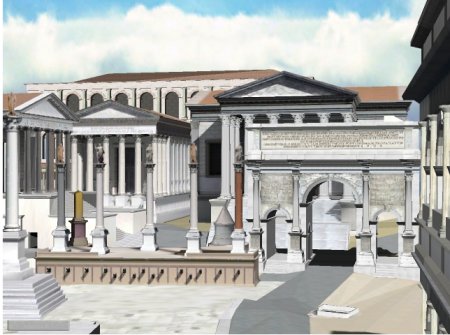
The Roman Forum of Yesterday.
That is the
Arch of Severus
on the right.
|
|
Back in the
days of Caesar, the architecture of the Roman Forum was
something to behold. Rome was at the peak of its power
and its buildings were definitely the most impressive
structures in the entire Mediterranean.
Unfortunately,
as you can readily see, the magnificence of the ancient
Roman Forum is utterly in ruins today. This is a shame
because all of these structures were built to last.
The Roman
Forum was built by slaves from the conquered nations.
Ironically, it was the Catholic Church that caused the
greatest damage. Thanks to the "Decline and Fall
of the Roman Empire", as these buildings lost their
importance, their materials became fair game for use in
building new churches around town. Many of the stones
in today's Vatican once lived in the Roman
Forum.
|
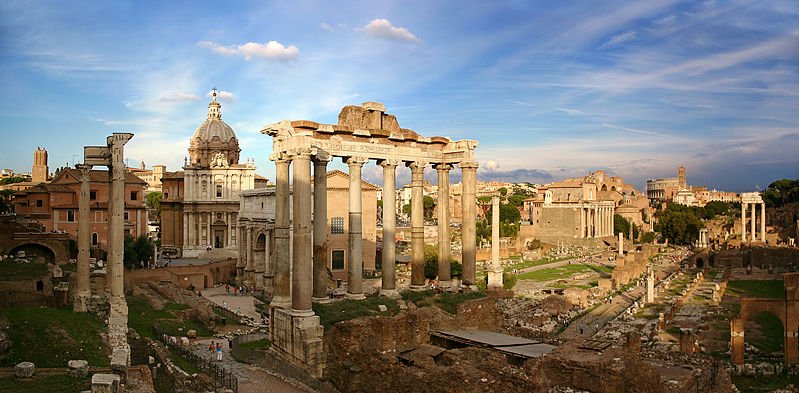
The Roman Forum of
Today. The
structure with the eight columns is the
Temple of Saturn.
Directly behind is the
Church San Giuseppe
dei Falegnami,
the
Arch of Severus,
as well as the
Curia.
|
|
|
OUR VISIT
BEGINS
As we left the
Campidoglio, I couldn't help but notice that
amazing statue above the white marble building. As I
studied my map, I determined that the white building in the
picture is the Vittorio Emanuele Monument
which is located next to the Piazza
Campidoglio. This building served as a useful landmark
throughout the day thanks to the distinctive Winged
Statue of Victory high above that could be seen from
practically every point in Rome.
The first building we passed was the
Church San
Giuseppe dei Falegnami.
Down below the church is a famous prison known as
Mamertino. Also known as Tulliano,
this was the oldest prison in Rome. First constructed in the
7th century BC, this was a prison for condemned enemies of
the State. According to legend, St Peter was imprisoned here
before he was martyred at the Circus of Nero and Caligula at
the site of the Piazza San Pietro. Other well known
prisoners were Vercingetorix the Gaul and
Simon bar Jiora, the Jew who defended Jerusalem
against Titus. Thanks to the tradition of St Peter's
imprisonment, his cell has been turned into a chapel
dedicated to St Peter. Legend says that shortly before
his death, St Peter brought forth a spring in the cell, and
used the water to baptize two of the guards, Processus and
Martinianus.
As we walked past this church, I had no idea of its
significance. Oblivious, I walked past it without
giving it even the slightest glance.
Next Marla and
I encountered a set of ruins behind the Vittorio Emanuele
building. As we passed this patch of ruins, I had
absolutely no idea this pile of rubble was all that was left
from the Forum of Caesar. There were
occasionally signs to be seen, but not for this area.
Otherwise I would have paid more attention. Instead I
simply took a picture and kept walking down the sidewalk
looking for the entrance to the Forum.
When we got to
the entrance, we made a very dumb decision. After Marla and
I paid to enter the Forum area, we noticed there was an audiotape we could rent
to guide us around the Forum and give us much-needed
information. This should have been a no-brainer, but
the catch was that we would have to return the tape when we
were done.
At the time, Marla and I actually believed
we would still have enough time and energy to WALK BACK TO
ST. PETER'S TRAIN STATION. Since we would have to go out
of our way to return the tapes, we chose not to have the
obligation. Ironically, later in the day we ran out of
time and opted to
take the subway back to the train station. This meant
we walked right past the ticket office on our way out.
I was furious with myself.
As we entered
the Forum, we soon discovered there was either no
description at all or only the barest written description of the areas we
viewed. As we wandered around the Forum, time and
again we would stare at broken unidentified rocks that had absolutely no
meaning for us. Thousands of years of history...
bloodshed, ambition, power, pain, sacrifice and heartache... were
contained in those rocks, but we had no clue as to the
stories behind them. Julius Caesar could have been
murdered right where we stood and we would have never known. Were we stupid or what?
|
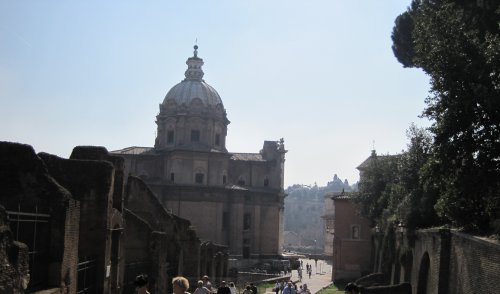
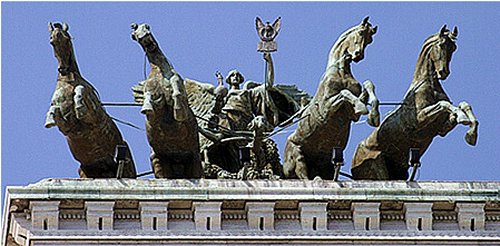
A look at
the Winged Statue of Victory
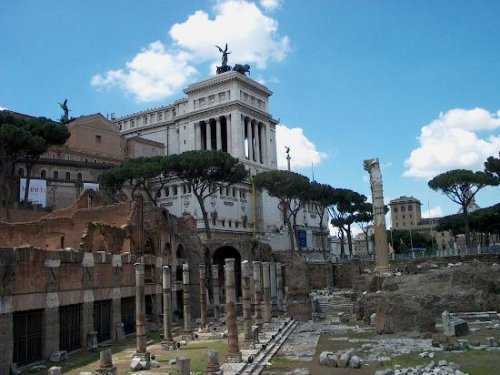
The Vittorio
Emanuele Monument with the Winged Statue of Victory.
As you can see, there isn't much to look at in the Forum of
Caesar
|
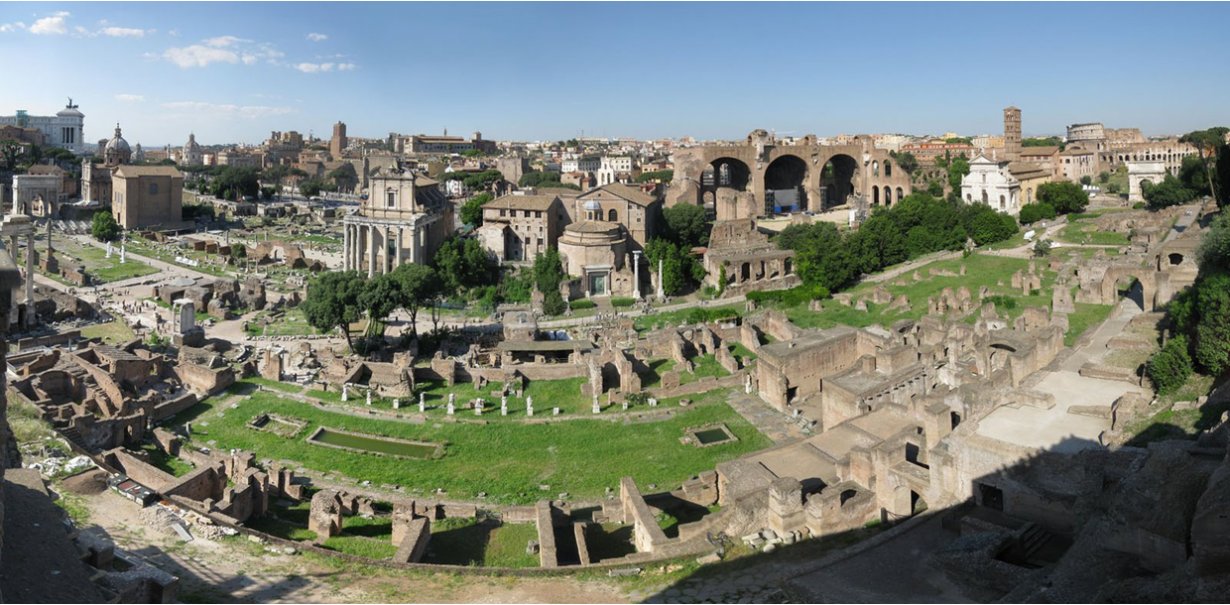
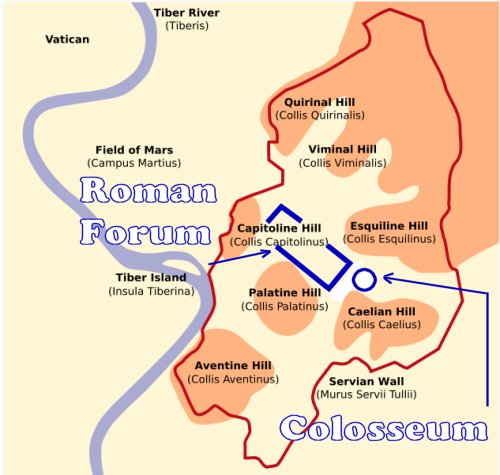
The Palatine Hill
and the Capitoline Hill overlook the Forum
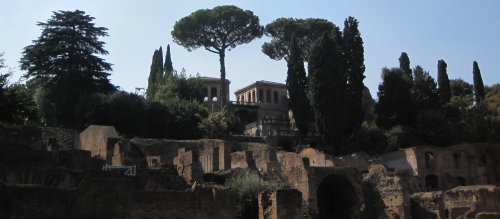
Palatine Hill
served as home to Augustus and many other Emperors.
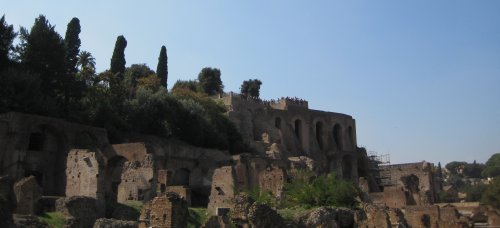 |
The picture
above provides a marvelous panoramic view of the Roman Forum taken
from Wikipedia. Although I had assumed the Forum
extended north and south, I later learned differently.
The Roman Forum stretches on a diagonal from the
Campidoglio and the Arch of Severus at the
northwest end
to the Colosseum and the Arch of Titus
at the southeast end.
Notice the
unusual curve
to the picture. I can assure you the Forum was built
on a straight line. For example, when I saw that green field in
the picture, it was straight, not bent. Maybe they
curved the picture to get more structures into
one shot or make them easier to see. The byline under this picture says
several different photographs were
"stitched" to create this one big picture.
Isn't modern photography amazing?
Now I have a
question. Do you have any idea what are the stories
behind all those buildings and all those broken rocks?
Me neither. The difference is I visited the place, so
you would assume I would know at least something.
Guess again. The structures in this picture were a
total mystery to me during my visit. I cannot begin to say how
embarrassed I felt at my total ignorance. I
wish again we had rented those guided tour audiotapes.
Truth be told, I barely learned a thing while I was there.
However,
through the miracle of the Internet and some guide books I
purchased, at least I was able to do a creditable job of research
after the fact.
The area occupied by the Roman Forum was once a marsh in the
valley between the Palatine and Capitoline hills.
The marsh was fed by
a stream running through headed to the Tiber. After
redirecting the stream into a canal followed by a massive
landfill operation, the area quickly became prime real
estate. This occurred in the seventh century BC when
the Etruscan kings still ruled the city.
The Palatine Hill had always been the prime
residential part of Rome. Not only did it overlook the
beautiful Tiber River on one side, on the other side it
hovered over the marsh valley. The leaders of ancient Rome
all lived up there. Once the marsh was filled in, it
was convenient for them to make sure this undeveloped area become
the focal point of Rome. They could walk to work!
For a thousand
years, the Forum was the center of civic life, commerce, and
politics. Then during the Middle Ages, the area was
completely forgotten. The most disastrous period
occurred during the Renaissance.
Pope Julius II
(1503-1513) planned to rebuild Rome. The Forum seemed
to him a convenient source of material so he ordered the Forum pillaged
for building supplies. Despite the protests of
Michelangelo and Raphael, the destruction of ancient
monuments went on rapidly. Ancient marbles were ground
up for the lime kiln. Huge buildings
that were almost perfectly preserved were suddenly demolished in
less than a
month's time. The area was then abandoned and reduced to a
meadow that was used as a cow pasture. The message was
clear. The Glory Days were long gone.
About a
hundred years ago, the city came to its senses and began to
actively preserve what little was left of the Forum.
Better late than never. Let us now
begin a pictorial
highlight tour of the important structures that still remain
today.
|
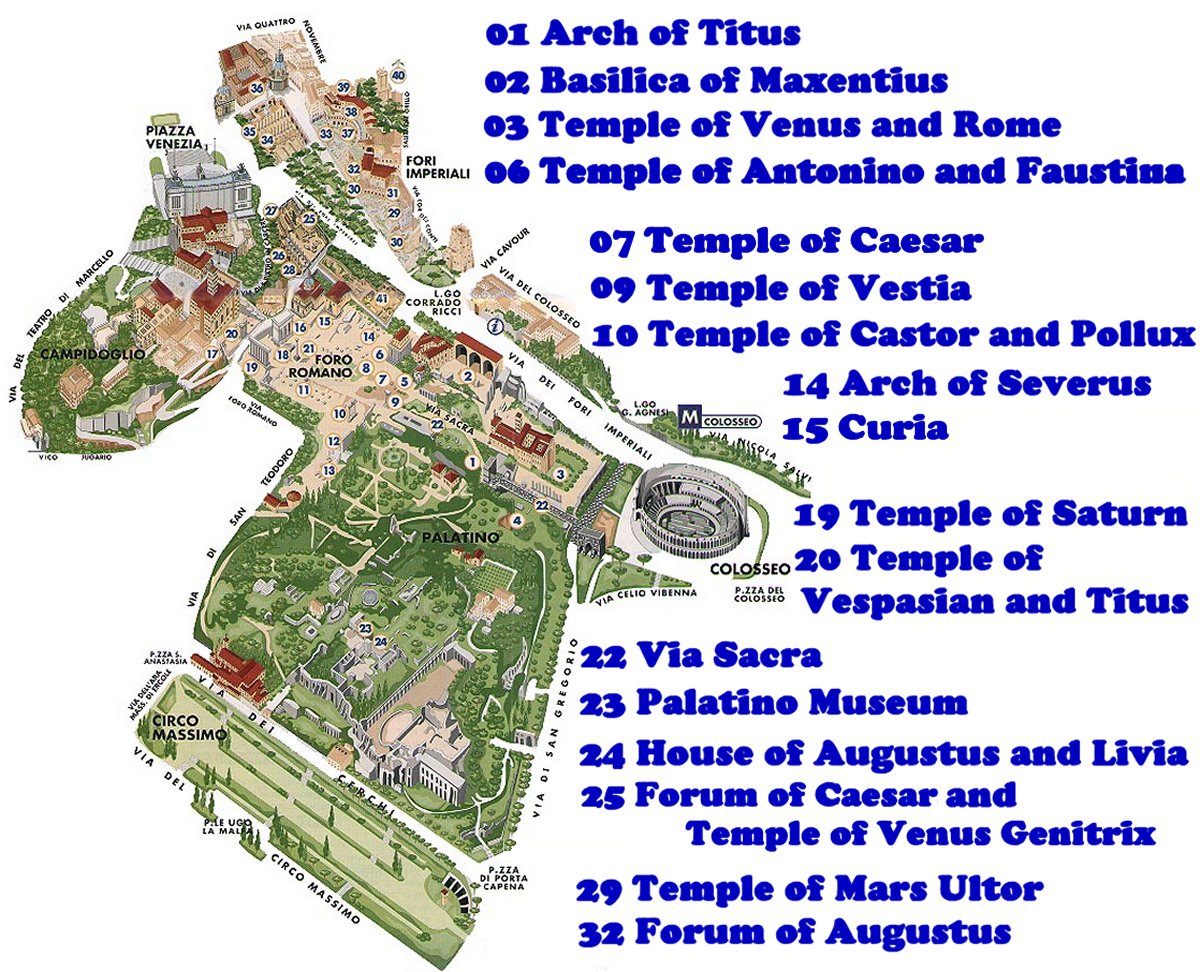 |
|
The Arch of
Septimus Severus (14) and The Temple of Saturn (19)
|
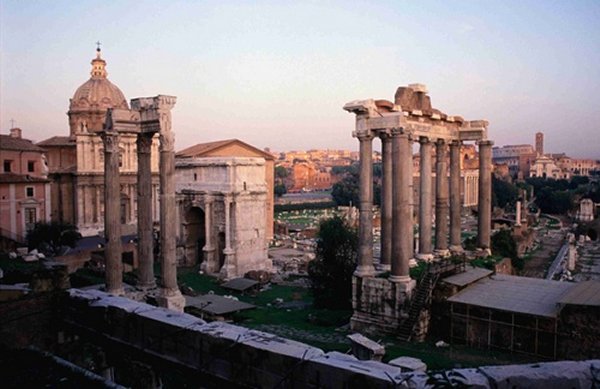
The eight columns are
all that is left of the
Temple of Saturn, circa 500 BC.
Notice the
Arch of Severus in the same picture. This is
the north end of the Forum
facing south. You can see the Colosseum way off at the
south end.
|
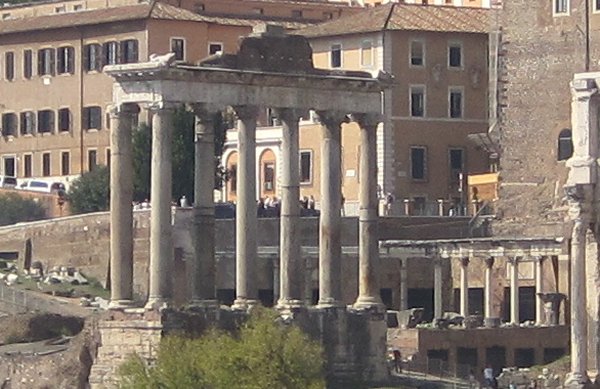
Here is a different
angle at the Temple of Saturn. Gradual collapse has left
nothing but
the remains of the front portico standing. The 8 surviving
columns and partially intact
pediment represent one of the iconic images of Rome's ancient
architectural heritage.
|
As I stared at
the broken rocks and incomplete structures, I had a hard
time imagining what these places really looked like.
Imagine my
delight when I discovered that many of the important Roman
Forum buildings have been digitally reconstructed.
What a miracle!
This picture gives you an idea of the magnificence of the
Temple of Saturn.
Yes, there are
the eight columns in front. Count them!
|
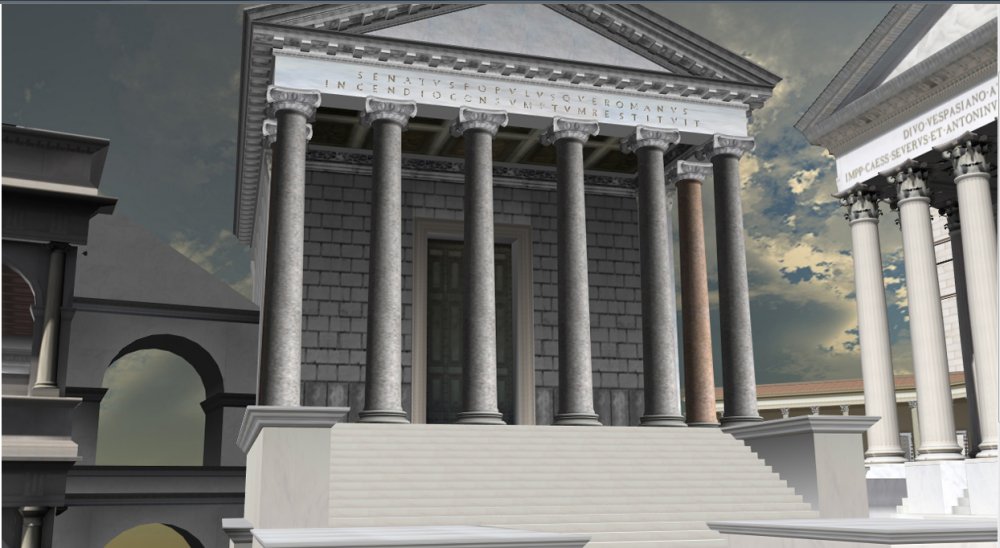 |
|
The Arch of
Septimus Severus (14) |
|
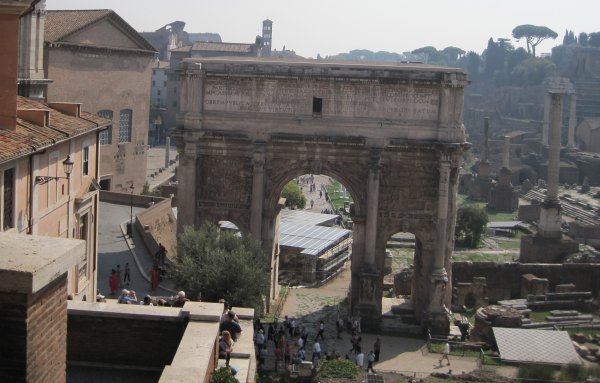
The white marble
Arch of Septimius
Severus is a
triumphal arch dedicated in AD 203
to commemorate the Parthian victories of Emperor Septimius
Severus and his two sons,
Caracalla and Geta, in the two campaigns against the Parthians of 194/195
& 197-199.
Parthia, by the way, is now northern Iran.
The Arch of Severus is located at the far northern end of the
Forum. The
Arch of Titus
is at the far southern end of the Forum. What is
remarkable is that both structures are
practically intact. Together the two structures serve as
bookends to the Forum.
They act as handy reference points for every picture taken of
the Forum.
|
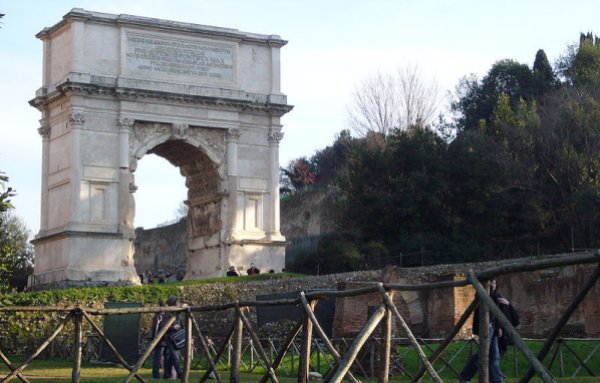
In AD 66 Jewish
zealots started a revolt against the Roman occupation of Judea.
Vespasian was sent from Rome to crush the revolt. After
Vespasian became emperor,
his son
Titus took
over. Titus captured Jerusalem in AD 70 with four legions
and the revolt was completely crushed after the fall of the
Masada fortress in AD 72.
In AD 79 Titus became emperor of the Roman empire. He died just
two years later, in September AD 81. The popular emperor was
soon deified by the Roman Senate. Emperor Domitian, Titus's
brother and successor, built the Arch of Titus that same year
both to honor his brother and to commemorate the victory in the
Jewish War.
|
|
Archeology |
|
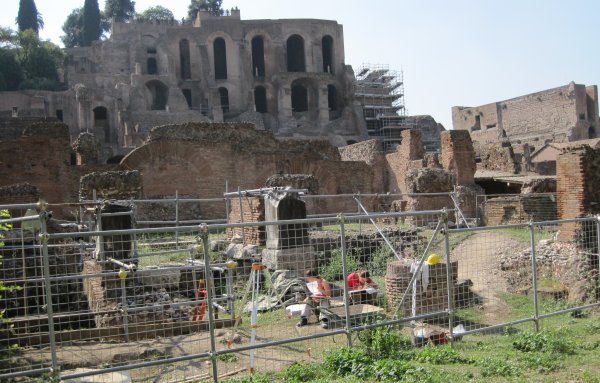
As Marla and I
strode through the Forum, we noticed several places where
archeology
students were busy excavating and documenting their work. The
Roman Forum has been called the greatest and most confusing
boneyard in history.
It seems such a shame that
the structures in the Forum were not only neglected, but
actively destroyed.
For example, today nothing remains of the Temple of
Jupiter,
once considered the greatest Temple of them all. Thank
goodness there are people dedicated to making sense of this
huge puzzle.
|
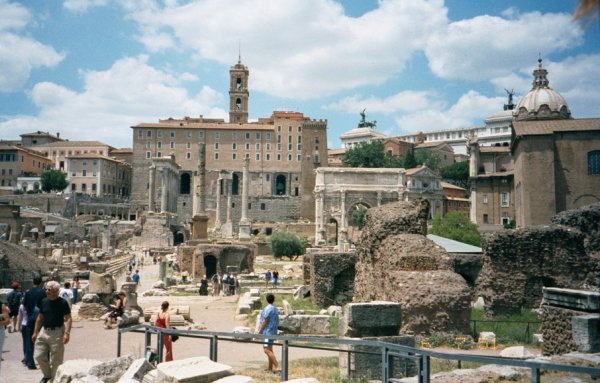
As I said, you
can orient yourself in any Forum picture using one of the
two Arches. Here you can see the
Arch of Severus
(as well as the Winged Goddess of Victory). Can you spot the
Temple of
Saturn?
Look for the distinctive 8 columns. Do you see any
signs that might explain the significance of each building?
Marla and I walked through the place all day long without a
clue of what we were looking at. Let me tell you - I
wasn't happy about this fact at all.
|
|
The Temple of
Vesta (09) and the House of the Vestals |
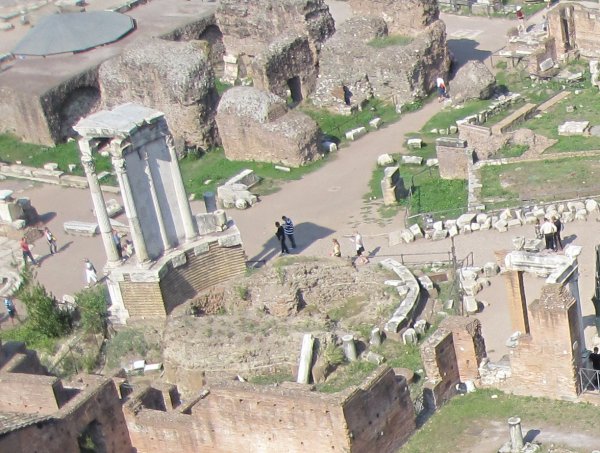
The
Temple of Vesta.
Not much left of this circular structure. The Vestals
were the virgin holy female priests of Vesta, the goddess of
the hearth. Their primary task was to maintain the sacred
fire of Vesta. The Vestal duty brought great honor and
afforded greater privileges to women who served in that
role. They were the only female priests within the Roman
religious system. The Vestal Virgins became a powerful and
influential force in the Roman state. When the dictator
Sulla included the young Julius Caesar on his death list of
political opponents the Vestals interceded on Caesar's
behalf and gained him pardon. Augustus included the Vestals
in all major dedications and ceremonies.
The Vestal Virgins were committed to the priesthood at a
young age (before puberty) and were sworn to celibacy for a
period of 30 years.
|
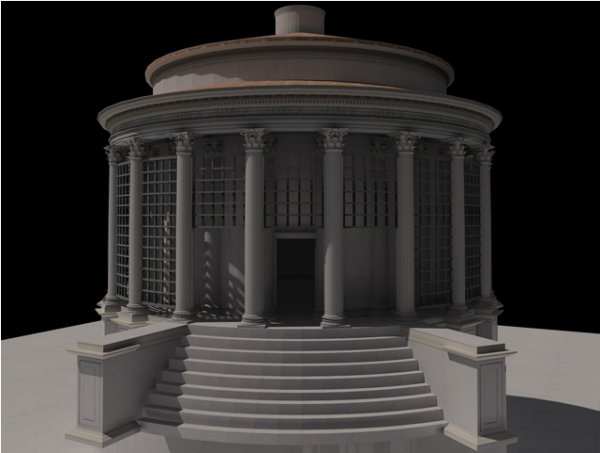
Here is the
Temple
of Vesta
digitally
reconstructed. These 30 years were, in turn,
divided into three periods of a decade each: ten as
students, ten in service, and ten as teachers. Afterwards,
they could marry if they chose to do so.
However, few took the opportunity to leave their respected
role in very luxurious surroundings. This would have
required them to submit to the authority of a man, with all
the restrictions placed on women by Roman law. On the other
hand, a marriage to a former Vestal Virgin was highly
honored.
Woe to the priestess who broke her vows. She was
condemned to the cruel punishment of being buried alive
since the blood of a Vestal could never be shed.
|
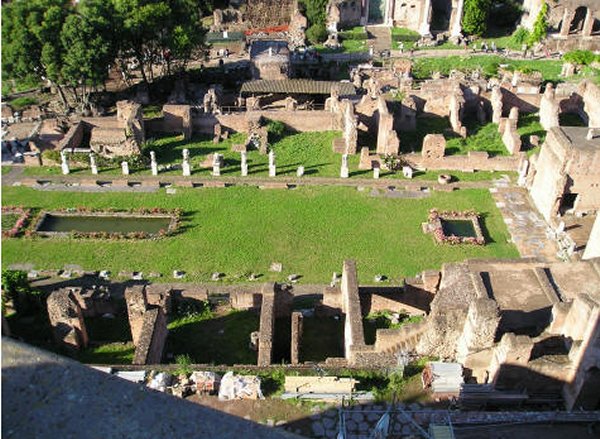
The Atrium
Vestae was a three-story 50-room palace built around an
elegant
elongated atrium or court with a double pool.
|
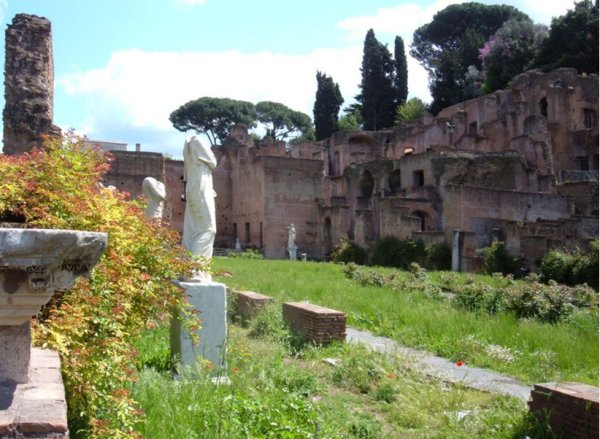
Those rooms
were also part of the House of the Vestals. Apparently
much of the place was destroyed in the huge fire during
Nero's reign.
|
|
Rome Yesterday and
Today/ Temple of Caesar (07) |
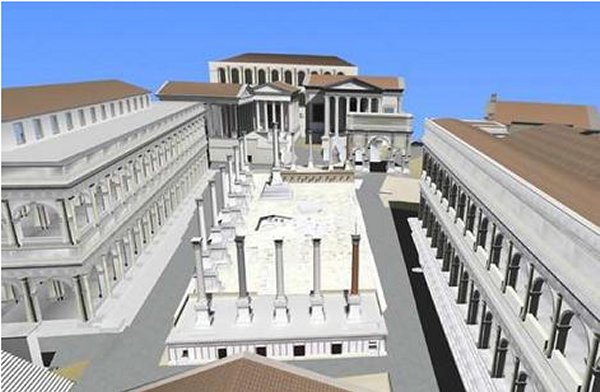
Here is a
computer recreation of the Forum facing north. This
means the
Colosseum
and the
Arch of Titus
are behind us. Do you see the
Arch of Severus
in the back on the right? On the left just next to it
is the recreated
Temple of
Jupiter.
Note the long courtyard in front of the
Arch of Severus
is the same in both pictures.
If you compare this picture to the one on the right, it
becomes painfully obvious just how much of the Forum was
destroyed.
|
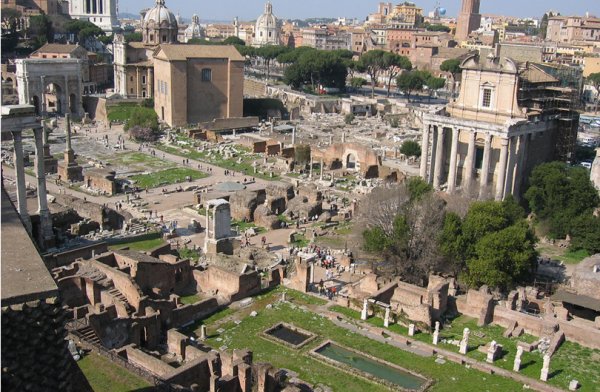
Do you see that
large circular metallic disk in front of the courtyard?
That plus the huge rocks behind it is what remains of the
Temple
of Caesar.
The tall brown building next to the Arch with the three
windows is the
Curia.
The Curia is where the Senate met in the Roman Forum.
In the 7th century, it was turned into a church which
explains why this structure survived intact.
That long walkway heading the Arch of Severus is part
of the legendary
Via Sacra,
the road used for all the Roman Triumph marches.
|
|
Temple of
Antoninus and Faustina (06) and The Temple of Vespasian and
Titus (20)
|
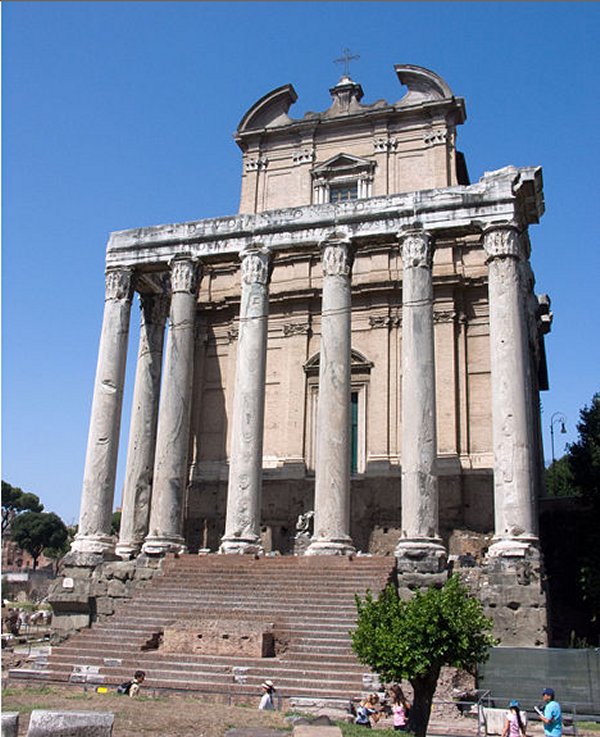
The
Temple of Antoninus and Faustina is one of the best preserved structures.
The temple was begun in 141 by the Emperor Antoninus Pius. It
was initially dedicated to his deceased and deified wife, Faustina the Elder. When Antoninus Pius was deified after his
death in 161, at the instigation of his successor, Marcus
Aurelius, the temple was
re-dedicated jointly to Antoninus and Faustina.
The structure behind the columns is the church of
San Lorenzo in
Miranda
|
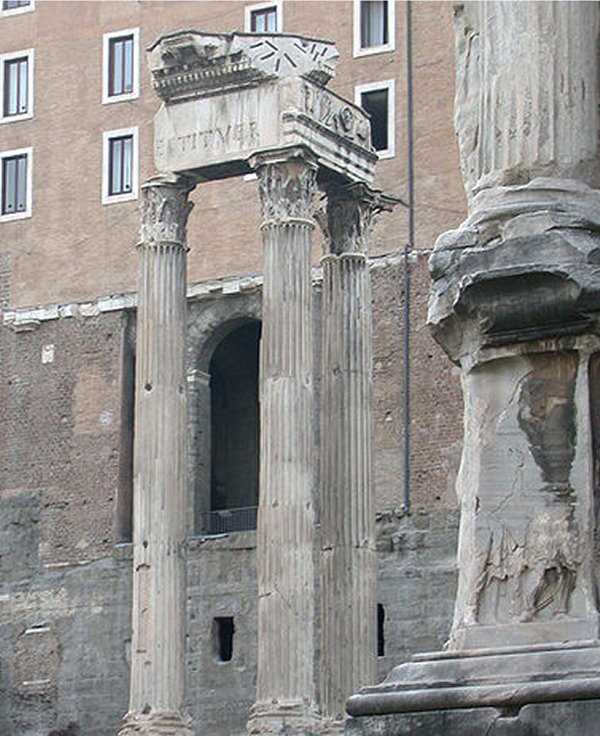
The
Temple of
Vespasian and Titus at the
northwestern end of the Roman Forum
is located between
the Temple of Concordia and the
Temple of Saturn. It is
dedicated to the deified Vespasian (builder of the Colosseum)
and his son, the deified Titus.
The Temple suffered great damage during the Medieval times.
Today only these 3 columns remain.
Both emperors are considered among the very best.
Unfortunately Titus was succeeded by his brother Domitian
who is considered among the worst.
|
|
The Temple of
Castor and Pollux (10), Basilica Julia and Church Santa
Francesca Romana |

Those three columns
are all that is left of the
Temple of Castor and Pollux.
In this picture, you are facing south. That is the
Arch of
Titus directly behind the Temple of Castor and Pollux.
Further in back to the left is the
Colosseum.
That row of rocks at the front are the remains of the
Basilica Julia
(11)
|
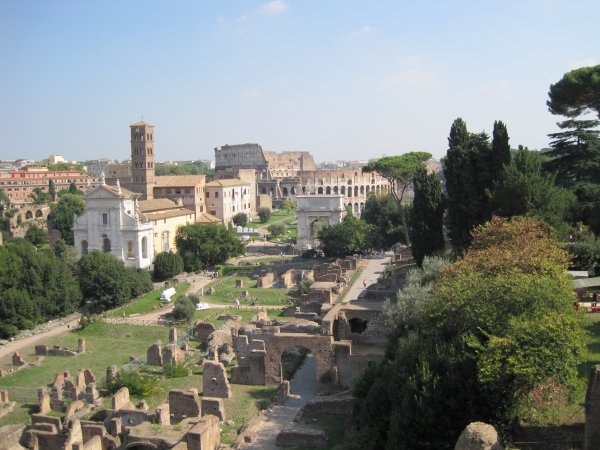
This picture
shows the structures directly in front of the
Arch of Titus.
That pretty white church plus the impressive bell tower behind it
is known as
Santa Francesca
Romana.
It is part of the
Temple of Venus
and Rome.
In case you are curious, I don't know what all those rocks
in the middle of the field were a part of, but an educated
guess says this was part of the House of the Vestals.
|
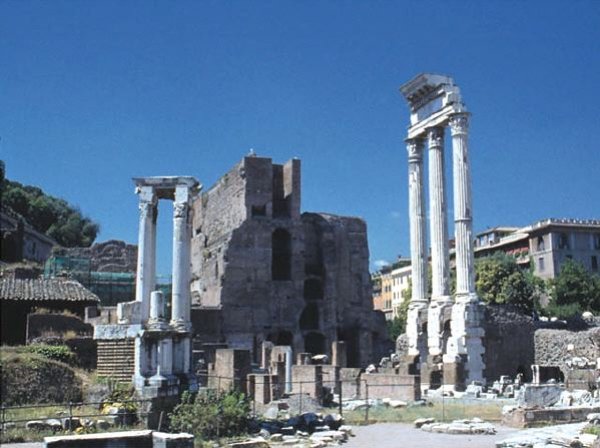
The columns on
the left are from the
Temple of Vesta.
The three columns on the right are from the
Temple of
Castor and Pollux,
also sometimes known as the Dioscuri, which is Latin for
Twins. By the way, the astrological sign Gemini is
named for Castor and Pollux. The Romans believed the
twins aided them on the battlefield, which explains why they
built a temple in their honor.
|
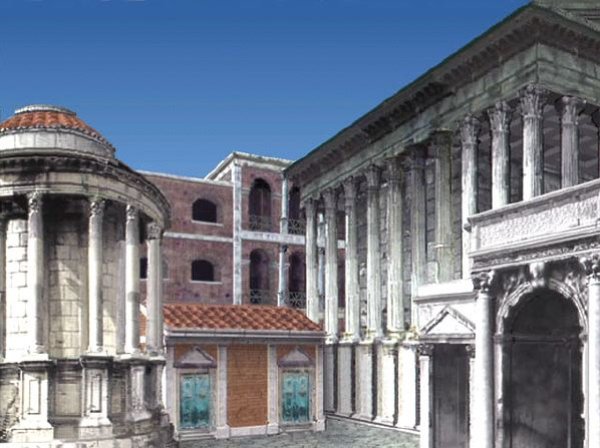
Here we have
the same picture. Isn't it amazing to compare the modern day
ruins with the digital reconstructions? Once you
fill in the blank spots, all those free standing columns and
rocks begin to make more sense. Thanks to this great
computer technology, we can see the exact relationship of
the Temple of Vesta and the Temple of Castor and Pollux.
|
|
Forum of Trajan
(next door to Vittorio Emanuele Monument) |
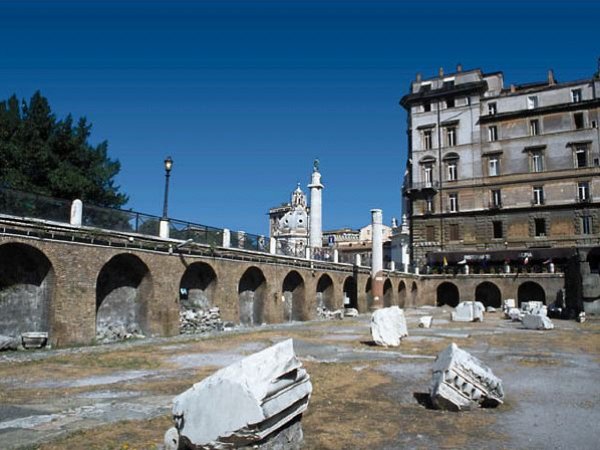 |
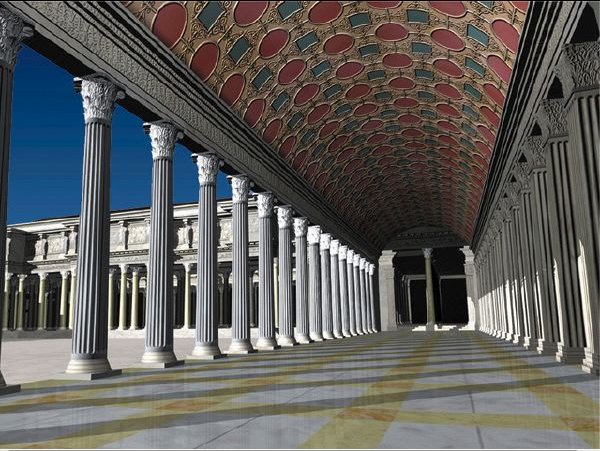 |
Above you can
see what is left of the
Forum of Trajan
and the recreation of the Forum of Trajan. Trajan was
one of the best Emperors.
After the terrible reign of Domitian and the ineffective
Nerva, Trajan was warmly welcomed as the new Emperor in 98
AD. Born in Spain, Trajan worked his way up in the
ranks of the military. He was chosen as Emperor for his
competence, not his birthright. Trajan justified their
confidence by governing well and without the bloodiness that
had marked Domitian's reign.
He freed many people who had been unjustly imprisoned by
Domitian and returned a great deal of private property that
Domitian had confiscated; a process begun by Nerva before
his death. His popularity was such that the Roman Senate
eventually bestowed upon Trajan the honorific of "Optimus",
meaning "the best".
Trajan was not
only a good politician, he was a terrific warrior. His
best known accomplishment was the conquest of Dacia, modern
Romania. Dacia had long been a very formidable
opponent of Rome. Trajan's Dacian campaigns benefited
the Empire's finances through the acquisition of Dacia's
gold mines. The victory was celebrated by building
Trajan's Column.
|
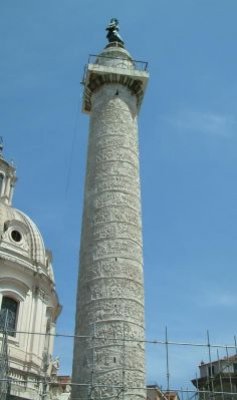 |
|
Temple of Caesar
(07) |
 |
The
Temple of
Caesar
is located in the very center of the Roman Forum.
Those columns you see in the front of the picture are the
remains of the
Temple of Vesta.
This area is
where the funeral of Caesar was held including the famous
speech by Mark Antony ("I come to bury Caesar") that
inflamed the mob against the people who had assassinated
him.
For the
funeral, a life-size image of Caesar had been made of wax.
In a very macabre touch, all 23 of the knife wounds were
shown. As Antony spoke, a mechanical device turned the
wax sculpture round and round so that people were able to
clearly see the 23 wounds in all parts of the body and on
the face. No wonder the mob was angry!
Marla and I walked right past these rocks several times
without any idea whatsoever of their significance. I
could just kick myself!
|
|
Via Sacra (22) -
Road of the Famous Roman Triumph Marches |
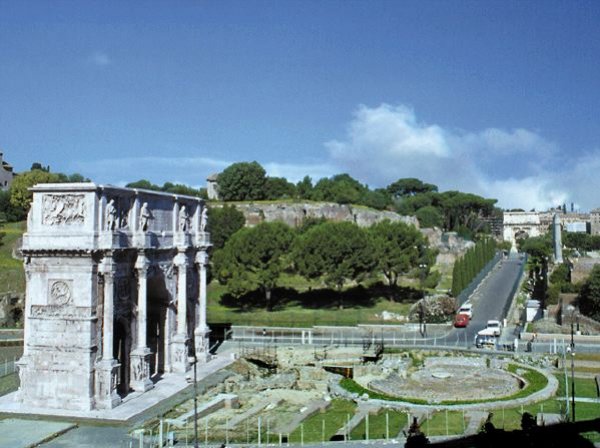
The
Via Sacra
(Sacred Road) is the main street of ancient Rome, leading
from the top of the Capitoline Hill, through some of the
most important religious sites of the Forum (where it is the
widest street), to the Colosseum.
This street was the most famous in ancient Rome.
The road was the major part
of the Roman Triumph. It
served as the route
taken by the triumphal processions
of victorious generals through Rome.
The victory march started on the outskirts of the
city, passed by the Colosseum, then
proceeded through the Roman Forum
first by crossing under the Arch of Titus and then later the
Arch of Severus. It finished nearby at the Capitoline
Hill to give thanks to Jupiter.
|
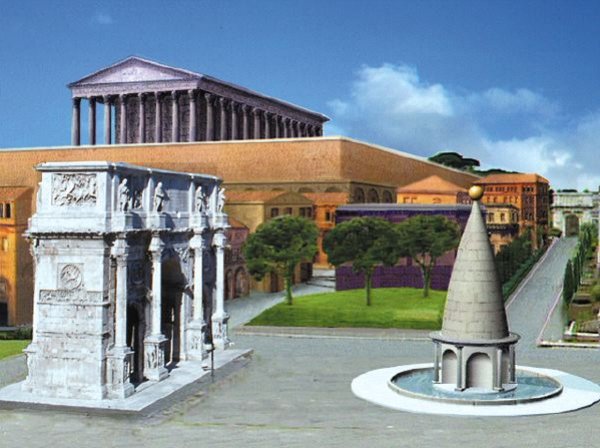
Here is a digital reconstruction of the
Via Sacra. In the fifth century B.C., the
road was supported by a substructure to protect it from the
rain. Later it was paved and during the reign of Nero it was
lined with colonnades.
The road provided the setting for many deeds and misdeeds of
Rome's history, the solemn religious festivals, the
magnificent triumphs of victorious generals, and the daily
throng assembling in the Basilicas to chat, throw dice,
engage in business, or secure justice.
The Via Sacra is still with us today. The best
way for a walk in Roman Forum is descending
down the Via Sacra,
although to the average person it appears as a mere
unimporant path through the Forum.
|
|
Rome Yesterday and
Today, Column of Phocas, Basilica Julia |
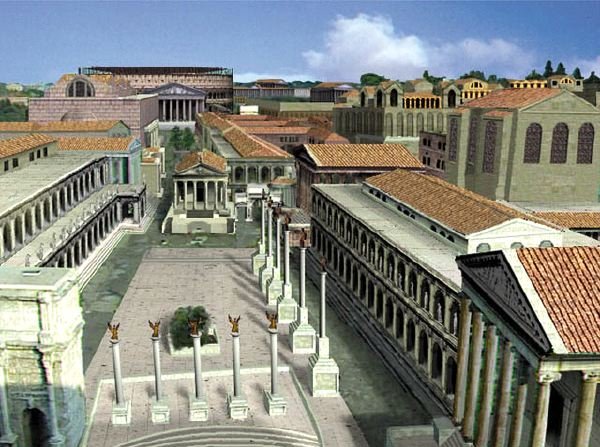
Earlier I
showed a reconstruction facing north. This
reconstruction faces south. The
Arch of Severus
is now on the front left. That is the
Temple of
Saturn
on the front right. That structure directly at the end
of the courtyard is the
Temple of
Caesar.
At the back of the picture you can see the
Colosseum.
You can barely see the white
Arch of Titus
peeking over the roofs in back. The small circular structure
next to Caesar's temple is the round
Temple of Vesta.
That long massive building on the right was the
Basilica Julia.
This ornate public building was used for meetings and other
official business during the early Roman Empire. The
building was initially dedicated in 46 BC by Julius Caesar,
with building costs paid from the spoils of the Gallic War.
The long building on the left was known as the
Basilica
Aemelia.
That hill on the right in the background is the
Palatine Hill.
|

All that is
left standing is the
Arch of Severus
and the
Temple of Saturn.
That walkway in front of the Arch of Severus is the famous
Via
Sacra.
That column standing all by itself in the middle is called
the
Column of Phocas.
You won't see it in the picture on the left because it was
the last structure built in the Forum (608 AD).
Emperor Phocas was so unremarkable that history doesn't even
record a reason for why the Column was built!
On the right, that row of rocks is where the
Basilica Julia
once stood. The three column structure just past the
Basilica Julia site is all that is left of the
Temple of
Castor and Pollux.
On the left, the
Basilica
Aemelia
is long gone. The building past where Basilica Aemelia
stood is the
Temple of Antoninus and Faustina
as well as the church of
San Lorenzo in
Miranda
|
|
Forum of Augustus
(32) and the Temple of Mars Ultor (29) |
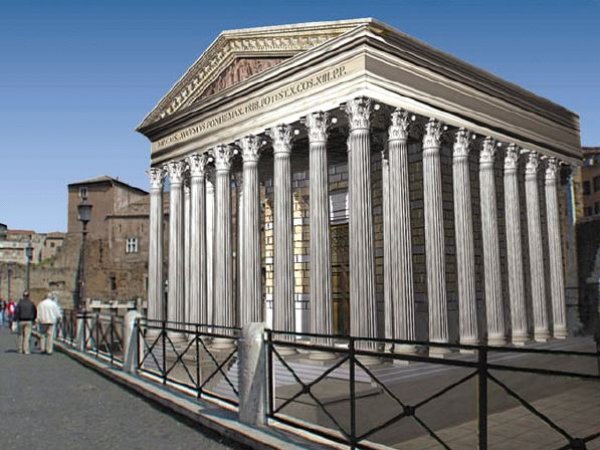 |
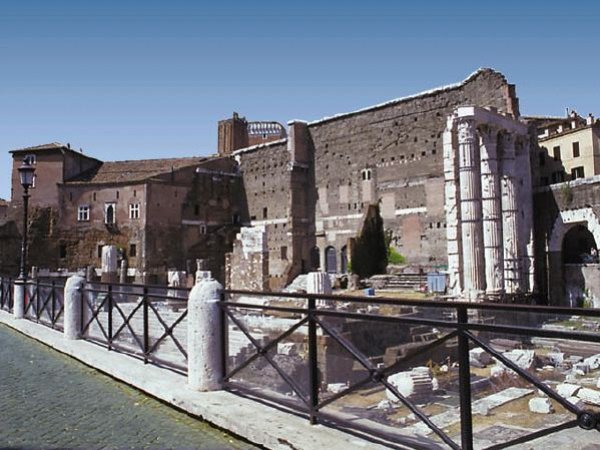 |
That
reconstruction is the
Temple
of Mars Ultor.
It is located in
Forum
of Augustus.
As the Roman Empire expanded, so did the bureaucracy
needed to run it. The Roman Forum literally
ran out of room for more buildings.
So
Augustus Caesar built a second forum across the
street. The
Forum
of Augustus
was built to both house a temple honoring Mars, the
Roman God of War, as well as to provide another
space for legal proceedings, as the Roman Forum was
very crowded.
Before battle, military generals set off their
departure from Rome at the Temple of Mars, after
attending a commencement ceremony.
Other ceremonies took place in the temple including
the assumption of the toga virilis by young men. The
Senate met at the Temple when discussing war and the
victorious generals dedicated their spoils from
their triumphs to Mars at the altar. Arms and other
stolen goods from the enemy, or booty, recovered
from battle were often stored in the Forum as well.
|
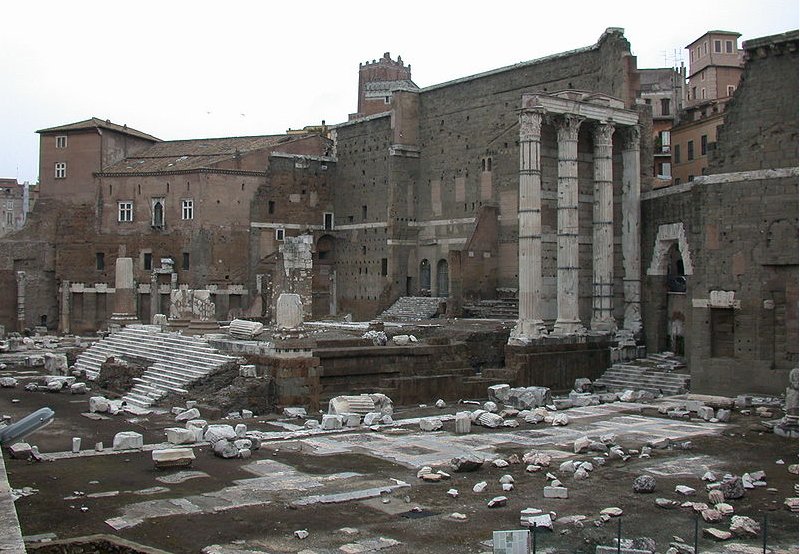 |
|
|
|
|
Temple of Romulus
(05) and the Basilica Maxentius (02) |
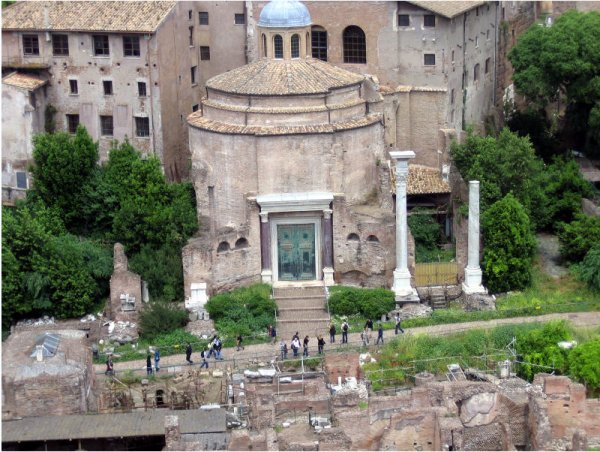
This is the
Temple
of Romulus.
|

The
Basilica of Maxentius.
|
As you
can see, the Temple of Romulus and Basilica of
Maxentius stand side by side in the Forum.
The
Temple of Romulus
was dedicated by Emperor Maxentius to his son
Valerius Romulus, who died in 309 and was rendered
divine honors.
The
Basilica of Maxentius
is a massive structure. It was the largest building in the Forum.
This Basilica had several purposes. One was to
serve as a huge warehouse. It was used as storage
for spices and peppers, valuable items of the day.
The
Temple of Romulus and the Basilica of Maxentius
occupy the middle part of the Forum about halfway
between the Arch of Severus and the Arch of Titus.
What is interesting to me about this picture are all
those unnamed structures out in the field in the
middle of Forum.
I don't know their exact purpose, but I assume they
were part of the
House
of the Vestals
which was very large and contained two courtyards.
That
walkway is all part of the
Via
Sacra.
That white church is
Santa
Francesca Romana
located
behind the
Temple
of Venus and Rome.
|
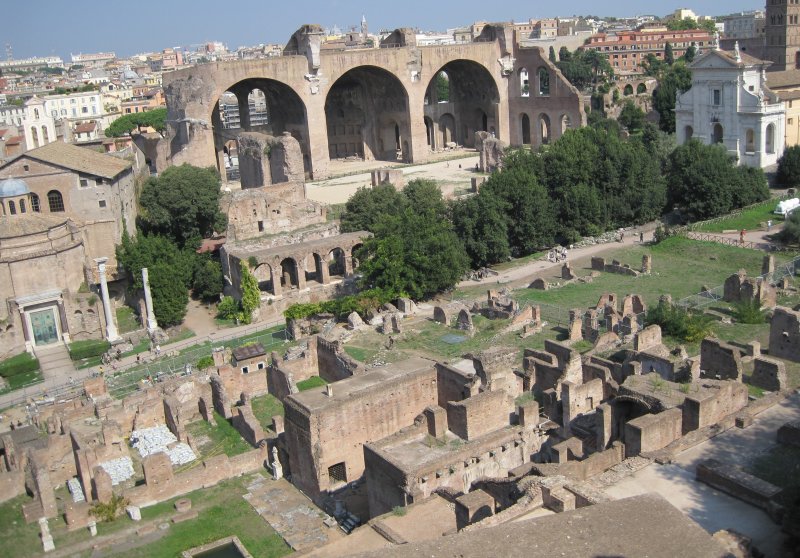 |
|
|
The Forum of
Caesar and the Temple of Venus Genatrix (25) |
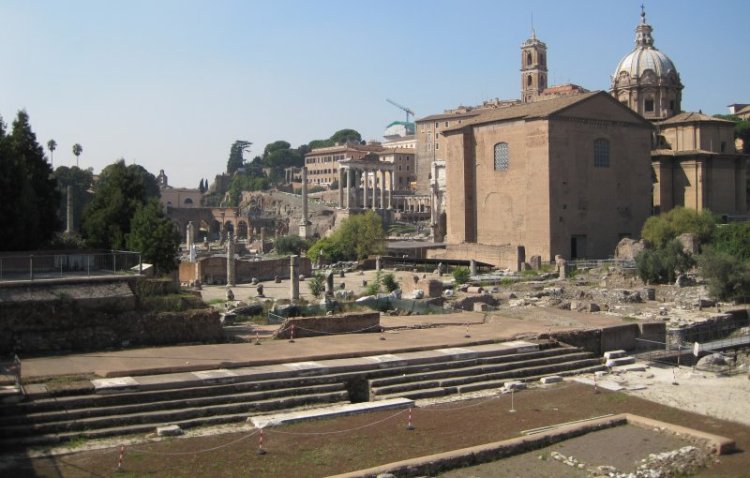 |
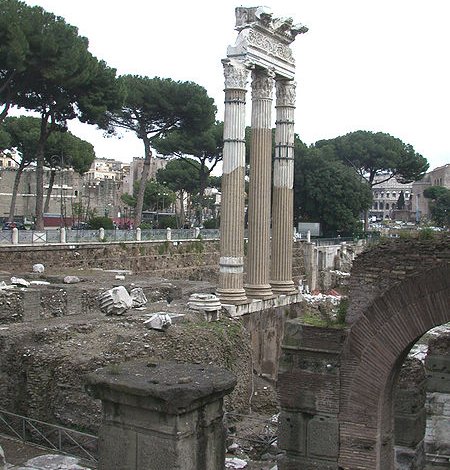 |
The most unsatisfying
part of the Roman Forum for me had to be the
Forum of Caesar.
That bare area in the picture above is all that remains of the Forum
of Caesar. Everything is gone!
When the Roman Forum had become too full of structures, Caesar
decided to build his own Forum right next door to the Roman Forum.
That large square brown building is the
Curia
where the Senate met. The
Arch of Severus
is peeking out at the side of the Curia. You can also see the
Temple of Saturn
in the background.
Caesar
attempted to build a temple inside his Forum. Those three columns
are all that is left of the
Temple of Venus
Genetrix,
goddess of motherhood. Sad to say, he never saw its completion
thanks to his assassination. The Roman Senate had to finish
the project for him.
Caesar's Forum
was situated along the
Imperial Highway
which went straight from the Vatican to the Colosseum (look for it
in the top right picture). In the picture on the right, you
can see that the Imperial Highway of today is still a busy
thoroughfare. As you walk the sidewalk, you can't help but
look down and see that the
Forum of Caesar
of today is nothing more than broken rocks and blocks.
But then I guess you can say that about all the structures here at
the Roman Forum. It is very sad to see so much greatness in
such a terrible state of disarray.
|
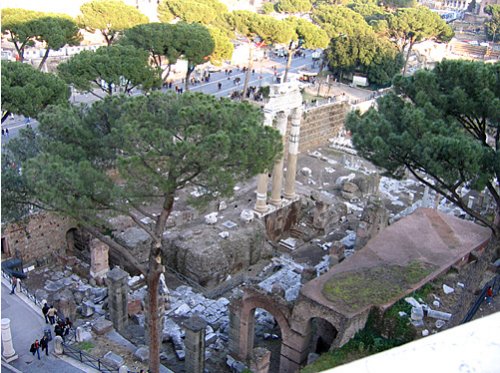 |
|
|
|
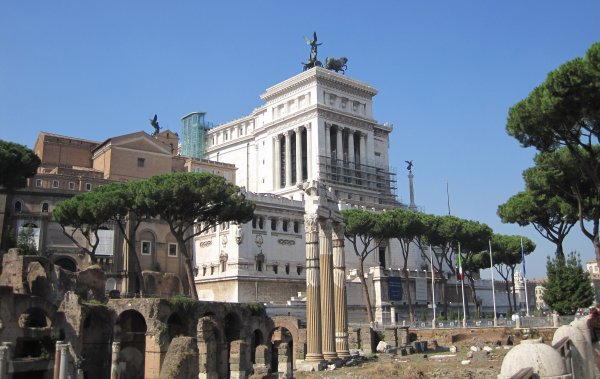
This picture
shows just how little remains of
Caesar's Forum.
When
Caesar decided to construct a forum bearing his name in the
northeast section of the Forum, he purchased a very
expensive, select amount of parcels of land in that area.
Forum construction began in 54 BC. It was dedicated to
Caesar and his deeds in 46 BC upon completion (probably with
the help of his nephew Augustus). Considering the staggering
cost and the personal interest that Caesar had invested
in the project, it is a shame he didn't live to see its
completion.
|
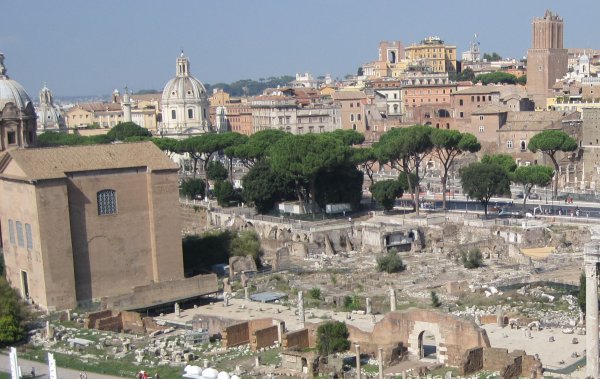
This look at
the
Forum of Caesar
from another angle shows convincingly it is nothing more
than rubble today. Someone completely demolished his
buildings!
My day in Rome was marked by one frustration and
disappointment after another. However I have to say
the absolute low point of the day was starting at the Forum
of Caesar trying to comprehend what on earth had happened to
this place. Little did I know it at the time, but I
would get my answer.
|
Forums Forums and More
Forums
There weren't very many
signs in the Roman Forum. However here is one that I found
helpful so I took a picture of it. It lists the various
different Forums.
I didn't understand
what this sign meant when I took its picture. I had assumed
there was only "one" Forum. After I did my research, I
realized that there were at least five extra Forums. One was created
by Julius Caesar, one by Augustus Caesar, and later Trajan added
another. In addition Vespasian created Templum Pacis ("Temple
of Peace") plus another emperor named Nerva created a Forum of his
own next to Caesar's Forum.
As you can see from the
map, all of these Forums line the Imperial Highway which leads
straight beside the Roman Forum on its way to the Colosseum.
That massive white building is the Vittorio Emanuele Monument at the
edge of Capolitine Hill. Across the street in blue is the
Forum of Trajan and his famous Column of Trajan. Next door to
Trajan in green was the Forum of Augustus. Across the street
from Augustus was the Forum of Caesar in gold.
|
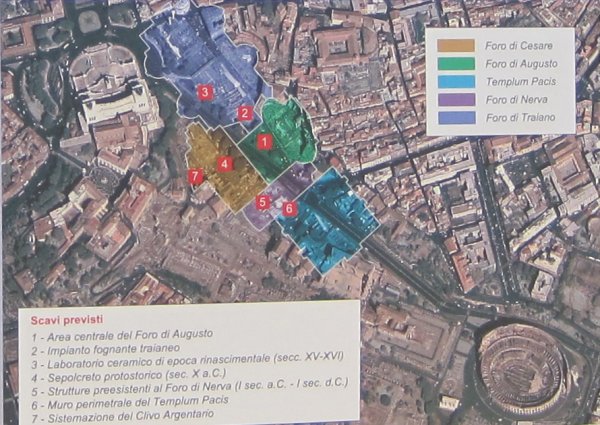 |
At the time, I
photographed this picture because it made me curious.
According to the picture, the different forums stretched right
across the Imperial Highway. That made no sense. For
some reason, I assumed the highway of today had simply been built
over the same route as the highway of yesterday. So why would
the Forum be bisected by today's highway?
I got my answer in various articles I ran across.
This excerpt provided my first clue. It gives some insight
into the fate of the Roman Forum in the years after the Fall of the
Roman Empire.
The Forum Romanum
The Forum Romanum, the old forum of republican Rome, was big
enough for the first seven hundred years or so of Roman History.
But in the Empire stage, Rome's need for public space as the
capital of a vast empire grew rapidly. Julius Caesar, Augustus,
Vespasian, Domitian (and Nerva), and Trajan all built their own
forums to satisfy that need for administrative space. Not
incidentally, the additions to the forums were meant to show the
wealth, power, and generosity of the donors.
The halls and basilicas of these expansive new constructions
served many functions. Rome had no permanent courthouses,
commercial and legal offices or university lecture halls.
Instead, tables, lecterns and seats were set up as necessary in
the broad halls of the basilicas and porticoes, and curtains and
temporary partitions were used to separate the different
sections from each other. Here, contracts were drawn up, and
court sessions were held. Commercial agents traveled from all
over the empire to meet here, as did professional orators,
philosophers, and poets who wanted recognition for their
talents. Exedras, open recesses at the edges of the forums
equipped with seats, served as lecture halls, as they had
previously in Greek gymnasia. All forum activities were open to
the public to a greater extent than in any modern administrative
state. Such openness was simply taken for granted. (Sessions of
the Senate, normally held in the nearby Curia, were also Public.
The doors were literally open whenever the Senate met.)
Large
parts of the Roman forum district were revealed to modern eyes
in the 1920s and 1930s, when the dictator Benito Mussolini drove
his own imperial road, the Via dell'Impero (now the Via dei Fori
Imperiali), through a lower class neighborhood from the
Colosseum to the Piazza Venezia.
Until recently,
however, the areas fronting on this road, beneath which were the
imperial forums, were occupied by streets, parks and parking
lots. Since 1996, archaeologists have excavated below these
green areas and parking spaces. The imperial forums dig is one
of the largest and most complicated urban archeological
excavations ever undertaken.
In contrast
to Mussolini's bulldozer approach, which simply destroyed
anything from later antiquity or the post-Roman period, the new
excavations have tried to rescue everything that could possibly
be saved. And now the work is nearly completed: today tourist
walkways above and through the Imperial Forums are beginning to
open.
The excavations revealed that the central areas of the forums
were subjected to systematic plundering as early as the 6th
century AD. Very little remains of the stone that paved the
open-air plaza of the Forum of Trajan or of the base of a
colossal equestrian statue of Trajan, which was nearly twice as
large as the Marcus Aurelius statue in the center of Piazza
Campidoglio. The statue itself is, of course, long gone. Even
the massive walls at the southwest end of Trajan's Forum can be
seen only by the empty trenches where the foundations once
stood: Romans have always been very efficient about recycling
construction materials.
Decline and fall of the imperial forums: There was a dramatic
decline in the fortunes and population of Rome after Constantine
established a new capital at Constantinople. Life in the area of
the former imperial forums came to a standstill. As early as the
first half of the 6th century and after the Gothic Wars, one
part of the imperial forums was already being used as a burial
ground for the poor, perhaps in connection with the church of
SS. Cosma e Damiano.
In the Carolingian period, there began a general recovery of
Rome, but, instead of reviving the forums, it led to their
literal dilapidation -- their stones (lapidi in Latin) were
taken away.
The forums of
Trajan and Julius Caesar were systematically dismantled and
plundered.
The extent and
consistency of the destruction suggest an organized effort,
probably related to the many construction activities of the
Popes Leo III and Leo IV. The few still-standing antique
structures in the forums were subdivided and reused.
The small early medieval city of Rome was away from the forums,
in the Campus Martius and Borgo districts, and the ruined areas
outside, including the forums, now assumed the semi-rural
character they retained until the 16th and 17th centuries. In
the 9th century, wine, fruits and vegetables were cultivated on
the plundered open spaces of the Caesar forum. Archaeobotanists
have found evidence of fig, cherry, plum and nut trees growing
between grape-vines and vegetable plots. The owners of these
gardens were probably wealthy families who had residences in the
city and defensive towers overlooking the old forums. By the
10th century, the former Caesar Forum was crossed by roads lined
by primitive, one-story houses measuring about five meters by
five meters. Since this terrain quickly turned muddy because of
the lack of a sewage system, the houses were rebuilt fairly
often at short intervals.
Beginning in the 11th century, the former imperial forums seem
to have been gradually urbanized during the next eight
centuries. A new, rudimentary network of streets eventually
arose to snake through the piles of ruins and newer, often
reproduced hovels in patterns that remained unchanged until
Mussolini's radical interventions of the 1930s.
More Information on the destruction of the Forum
Submitted by
Bija Knowles on Thursday,
07/23/2009
The Road Through the Forum
- An exhibition opening today at the
Musei Capitolini in Rome shows the building of the city's
infamous via dei Fori Imperiali (previously via dell' Impero),
which also tore through the forums of Nerva, Augustus and
Trajan, with little regard for the ancient Roman
constructions that lay beneath.
Via Dell' Impero - Nascita di una Strada (Birth of a
Road) will feature photos, paintings and sketches by
professional Roman photographers and artists, including
Filippo Reale, Cesare Faraglia and Odoardo Ferretti. The
exhibition runs until 20 September, documenting the
demolition of buildings and the excavations which took place
before the via dell'Impero was constructed.
In the 1930s, Italy was under the dictatorship of Benito
Mussolini, leader of the National Fascist Party. The
Fascists took some inspiration from the Roman empire and to
a certain extent modelled their large, colonnaded
constructions and expansionist ideologies on the
civilisation they saw as their political and cultural
predecessors. In fact, by 1936 Mussolini was using the title
'Founder of the Empire' as part of his official name. It is
surprising then, that during the 1930s a strip of land 30
metres wide, between Piazza Venezia and the Colosseum in
Rome, was stripped of its buildings (some medieval, many
residential) in order to make way for a grand road: one that
was worthy of a grand triumph in true Roman style.
Also on show are some of the objects found during the
excavation work, including marble statues and fragments of
painted Roman plaster. While care was taken during the
excavation to preserve thousands of these objects, most were
stored in crates in the Capitoline Museums and were labelled
simply as 'Via dell' Impero', so little further information
is available about their exact location of discovery.
Among the more surprising finds during the road's
construction was a prehistoric elephant's tusk, proving that
the Romans, or even the Etruscans (or should that be 'Etuskans'?)
were certainly not the first inhabitants of the Roman Forum.
Sixty photos go on display, documenting the demolition of
buildings and the excavations which took place before the
via delll'Impero was constructed.
While Mussolini is usually the sole object of blame when
lamenting the parts of the Roman Forum lost forever beneath
Rome's busy four-lane road, it is worth pointing out that Il
Duce's desire to 'improve' Rome, while giving what we would
call insufficient regard to its heritage, was part of a
wider movement that started when Italy was unified in around
1871.
At yesterday's press preview, the museum's superintendent,
Umberto Broccoli, urged the gathering of assorted Italian
journalists to see the creation of via dell' Impero as a
continuation of the siege of Rome in 1870, after which Rome
and Lazio were annexed to the Italian state. During this
siege, the Aurelian walls were bombarded and badly damaged –
showing that swathes of modern history will inevitably sweep
over the remains of the past and leave their own marks.
Following the unification, troops from Piedmont occupied
Rome and, once again, the face of the city was changed, with
many old buildings being painted in Piedmont's colours.
That the politicians, archaeologists and architects of the
past century had a different attitude to conserving Rome's
heritage is beyond doubt but, according to Broccoli, the via
dell' Impero was not simply a product of Mussolini's crass
desire to build a grand capital for his very own empire.
Rather, it is set in the historical context of about 80
years (from 1870 to the end of the second World War), during
which Italy as a nation was establishing its new political
identity. This exhibition gives an insight into the
construction and excavations of the 1930s, which changed the
face of the Roman Forum, as well as modern Rome, forever.
|
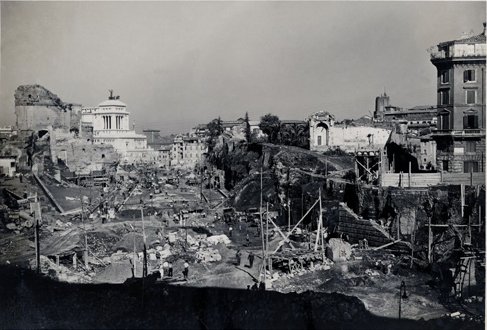
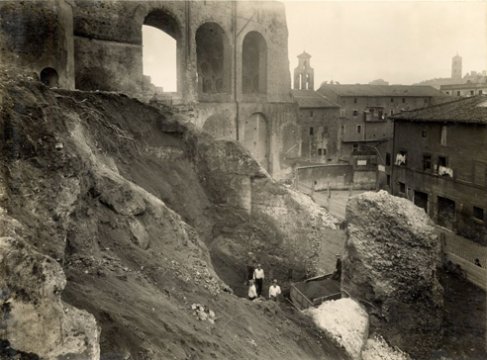
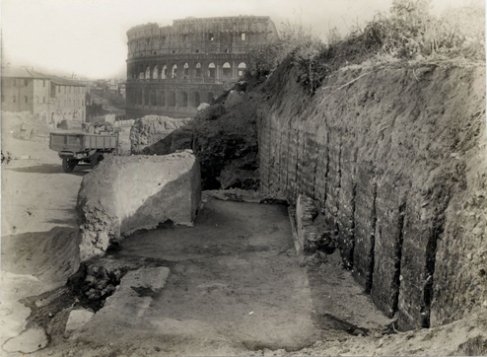 |
As
many readers will know, Fascist dictator Benito Mussolini carved an
imperial procession route through the heart of the ancient Roman
city center, laying a wide road, now called the Via dei Fori
Imperiali, that stretches from the Colosseum to Piazza Venezia.
In creating the
road that he called Via dell’Impero or Street of the Empire (the
name was changed in 1945), Mussolini and his archaeologist, Corrado
Ricci, destroyed a great number of renaissance and medieval
buildings and quickly plowed through any number of ancient
archaeological deposits as well as important ancient buildings and
their surroundings.
Starting
tomorrow, 23 July, the Capitoline Museums will be hosting an
exhibition documenting the vast process of demolition and excavation
by which the road was created and Mussolini’s excavation of parts of
the Forum of Augustus, the Forum of Caesar, the Forum of Nerva, and
the Forum and Markets of Trajan.
140 works —
among them photos, paintings, frescoes, and ancient sculptures —
will be on exhibit. The exhibition is titled “L’invenzione dei
Fori Imperali. Demolizioni e scavi: 1924-1940,” and it will remain
on view until 23 November.
Rick Archer's Note:
Well, I guess
now we all know what really destroyed the Forum of Caesar
and many other sites as well. It wasn't completely the fault
of the Catholic Church after all. Oddly enough, the
controversial highway did some good as well. First the
destruction stirred up so much anger that people began to demand
preservation of what was left. Second, there will many
accidental discoveries that created new curiosity. Third, the
highway reopened a virtually abandoned part of Rome to tourism.
This brought world-wide scrutiny to the lost area, which in turn
convinced Rome to protect its remaining heritage from further damage
plus find ways to display it.
|
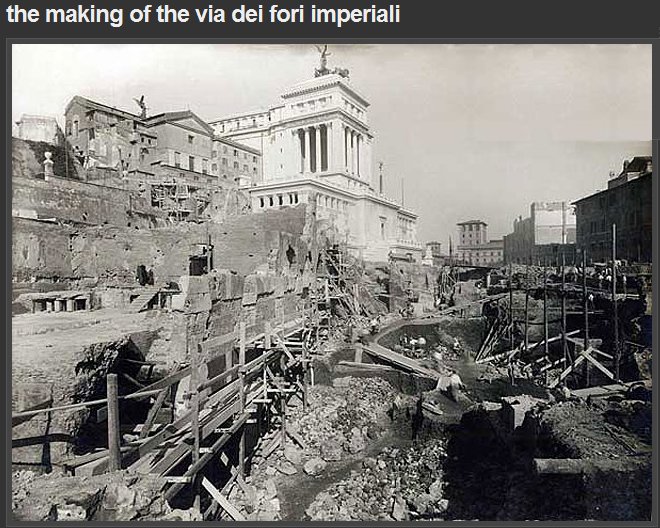 |
|
|
|
|
The Palatine Hill |
By the time
Marla and I made it to the top of the Palatine Hill, we were
ready to drop. For much of the time, Marla found a
shady spot and sat quietly while I wandered around taking
pictures of one set of ruins after another.
There is absolutely nothing else up on this hill except the
various ruins you see in the picture. The entire area
is now devoted to archeology.
|
 |
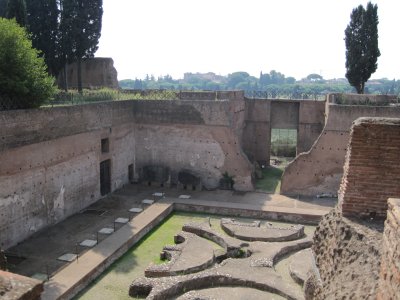 |
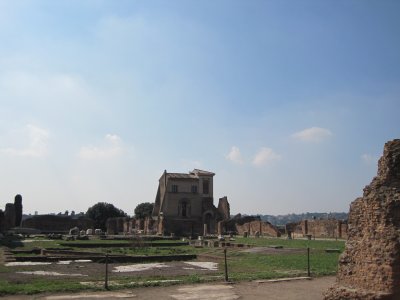 |
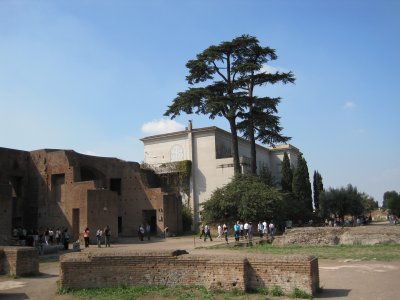 |
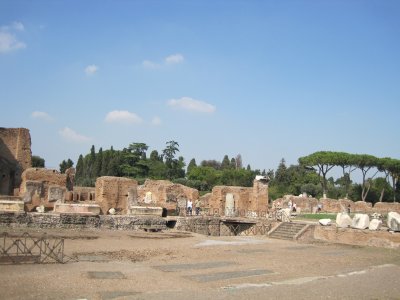 |
These structures
were all once palaces. Flanked by the Roman
Forum on one side, Circus Maximus on
the other, and the Colosseum on the southeast
end, the Palatine Hill was pretty choice real
estate. It served as the luxury home center of the
city. The area is enormous, so there was plenty
of room for at least two dozen different palaces, maybe
more. As I walked around, I was feeling
pretty irritated because none of these houses had any sort
of identification or a hint as to the story behind them. I
frowned because I knew full well there had to be incredible
tales hidden in those rocks. For example, you have no
idea who Livia is, do you? One of these days I am
going to tell you a story about Livia that is going to
absolutely knock your socks off.
The Palatine Hill and its counterpart the
Capolitine Hill were always the twin towers of
Rome. These two hills marked the original geographical
center of the ancient. The other five hills of Rome
created a perimeter around the two center hills and were on
the outskirts of the city.
The first people of Rome lived up on Palatine Hill.
When Augustus Caesar, the famous first Emperor of Rome,
built his palace up here, his excavators kept running across
one artifact after another. They would bring the
relics to show Augustus. He was so impressed at all
the history located up here that Augustus formed an
archeological team of his own to preserve various structures
as they were uncovered.
|
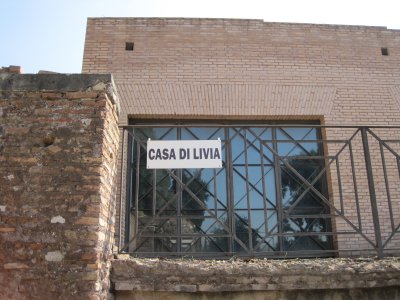 |
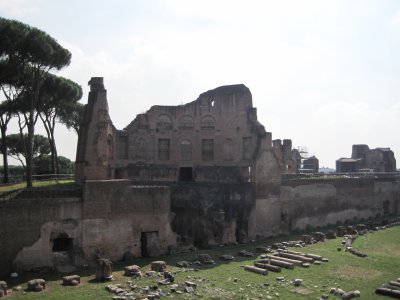 |
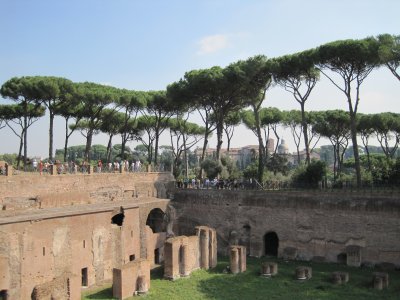 |
|
Circus Maximus |
As I was
wandering around what I believed to be the palace of Augustus
Caesar, I walked over to the edge of a rock wall and peered
over.
Down in the valley below, I saw an enormous
field (not the immediate field, but the dusty one further
down). Big deal. Clueless as usual, I was about
to walk away when a small voice suggested I turn back
around.
I took a glance at the Forum map and was stunned to realize
that field was where the ancient Circus Maximus
was located. Crowds the size of 250,000 people would
gather there to see the chariot races.
Surely you remember
the incredible chariot race in the movie Ben Hur.
In the book version, Ben Hur was a Judean prince who was captured and sent to Rome
as a slave. A wealthy Roman Senator purchased him and
put him to work racing chariots at... you guessed it...
Circus Maximus.
In the book, Ben Hur won so many races that he became a
local hero. The
Senator gave him back his freedom as a reward. When
Ben Hur returned to Judea, he used the skills he had
acquired in Rome to defeat Messala, once his friend and now
his most bitter enemy, in the amazing chariot race (easily
the most incredible pre-CGI spectacle ever filmed).
In the digital
recreation, you can see the Palace of Augustus
overlooking Circus Maximus. The building on
Capolitine Hill in the background was the
Temple of Jupiter that no longer exists today.
Thinking about the chariot race in the move Ben Hur
still gives me goosebumps. There is no doubt I am
drawn to Rome in a big way. There is so much history
in this place.
|
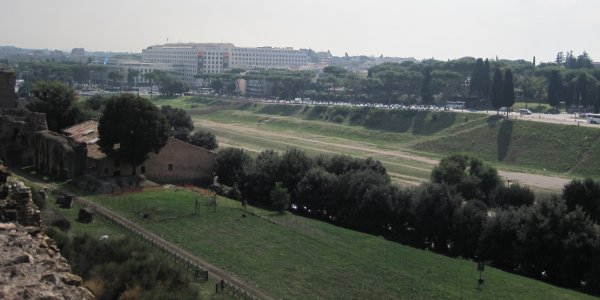
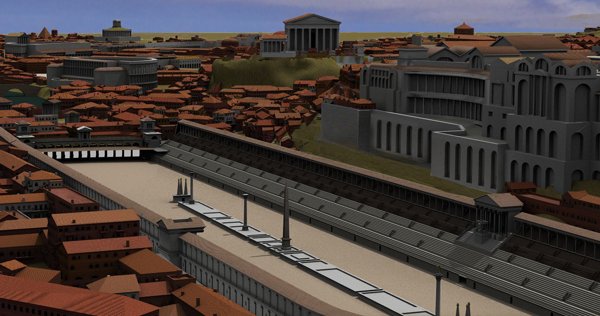 |
|
|
Parting Thoughts |
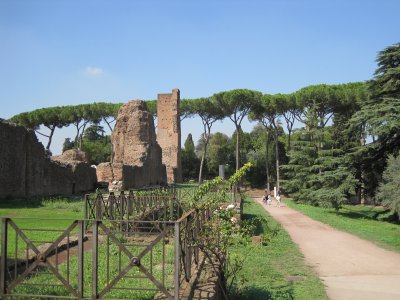 |
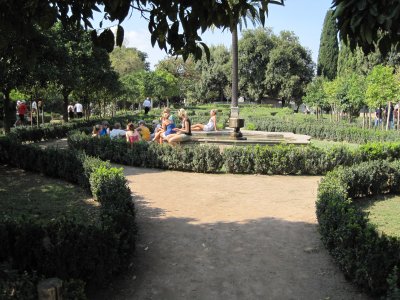 |
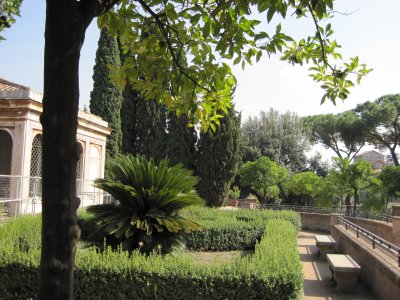 |
After I woke up from my
Circus Maximus daydreams, I went back to fetch Marla.
We were both fighting exhaustion from the heat and all the
walking. Neither of us said it, but we were both
thinking what a shame it was we didn't take the subway over
here so we would have had more energy to explore the Roman
Forum.
Slowly but surely, together we trudged over to a much
prettier part of the Palatine Hill complete with gardens and
lovely trees. We ended up at a lookout point on the
edge of the Palatine which gives a wonderful view of the
Forum down below. While I was up there, I took
advantage of the spot to snap many of the pictures used in
this story.
By chance, I overheard a tour guide sharing an
anecdote about the
Temple of
Antoninus and Faustina
which was in full view across the way from this lookout
point. A group of twenty people were hanging on every
word the tour guide had to say. Curious, I ambled over
so I could hear better. The guide told of some scandal
related to the building of that Temple. Obviously this
guy was privy to some pretty fascinating inside information
The crowd roared with laughter and approval. They were
having a great time! (Unfortunately, I could not hear
well enough to be sure what he said nor was I able to find
the story on the Internet. Believe me, I looked).
As I heard the peels of laughter, I wished more than
anything else that I could join this group and have some of
the mysteries of this incredible place unveiled.
Thanks to this talented man, these people had a walking
talking history book right in front of them. This man was
able to give voice to the incredible stories enclosed within
these forgotten and neglected stones. I was so envious
of these people that they had this guide who could make all
this rubble and deterioration come back to life before their
very eyes. Meanwhile I seethed with bitterness.
Their joy aggravated me because they brought all the
disappointment I had encountered so far on my
self-proclaimed "do-it-yourself" day into sharp focus.
As I peered out from my vantage point, I could see the
well-preserved Arch of Titus. I smiled
as I noticed the space next to it where a giant statue of
Nero known as the Colossus had once
stood. In fact, the nearby Colosseum got
its name from that statue. Nero wasn't the most
popular guy in Rome, so his statue didn't last very long.
There sure are a lot of places in Rome that have been
destroyed. It sure made me sad to think of all the
destruction of these amazing structures.
It was time now to head home. Little did I know that
before the day was over, there were yet two more
incomprehensible humiliations waiting for me just around the
corner.
|
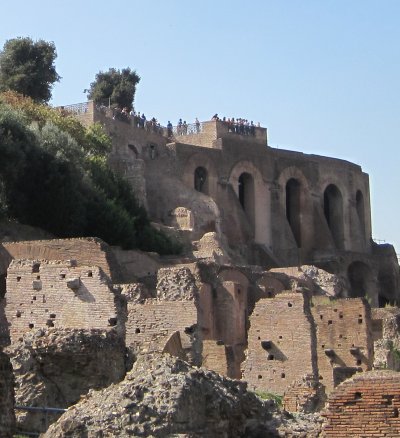

You won't
see the Colossus of Nero any time soon |
|
OUR
NEXT STORY: ROME REBORN
|